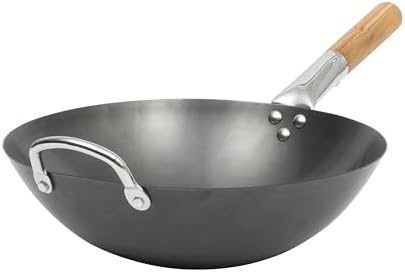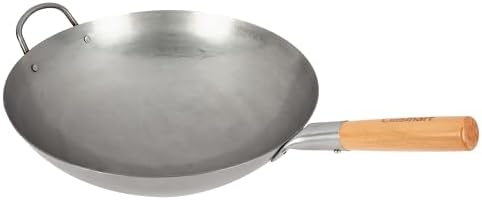Choosing the Right Wok
When deciding on a wok, there are a number of considerations to be kept in mind like the type of material, cooking technique, and upkeep. The most common woks are the conventional carbon steel and non-stick woks. They both have their own special characteristics that may influence your cooking.
Most chefs prefer carbon steel woks because they conduct heat well. They heat quickly and distribute heat evenly, making them well-suited to high-heat cooking techniques such as stir-frying. The wok develops a natural non-stick surface over time if seasoned correctly, which gives food texture and flavor. Carbon steel woks do require special maintenance, however, since they will rust if not cared for correctly. Periodic seasoning after cleaning is necessary to preserve its cooking qualities and appearance.
Non-stick woks, however, offer ease and convenience, especially for those who are new in the kitchen. It requires less oil in cooking, which reduces the calorie content of food. Non-stick surfaces also facilitate cleaning since food does not stick easily. However, these woks are less tolerant of high heat compared to their carbon steel counterparts, and that may interfere with their performance in certain cooking methods. Non-stick coatings also wear out over time, especially if metal utensils are used.
Your own cooking style and preference should also be significant factors in your decision. If you like high-heat cooking and vibrant stir-fries, a carbon steel wok can be more suitable. If you prefer hassle-free cooking and cleaning, a non-stick wok can be more suitable for you. With these factors and understanding the difference with regards to durability, performance, and maintenance, you can make a smart decision that would complement your cooking endeavors.
Cleaning Your New Wok
Before embarking on the seasoning process of your new wok, it is essential to thoroughly clean it to eliminate any factory residues or protective coatings that may be present. This initial cleaning will prepare your wok’s surface for the seasoning, ensuring that the flavors developed during cooking are not compromised by lingering chemicals.
To start the cleaning process, bring a large pot of water to a boil. Gently place your wok into the boiling water and allow it to stay for a few minutes. Heat will help soften the factory oil or coatings. Following this, it is advisable to take a non-abrasive sponge or a soft cloth and gently scrub the interior surface of the wok. Do not use strong chemicals or soaps, as these will leave behind undesirable residues and could influence the cooking qualities of the wok.
As you scrub, pay special attention to areas that have an oily or greasy feeling, as there may be residual coatings in these spots. Be sure that you are thorough about it, getting the sides and exterior of the wok as well. When you are satisfied with the scrubbing, rinse the wok thoroughly with hot water to remove any loosened debris.
After rinsing, it is necessary to dry the wok completely. Woks are generally made of carbon steel or cast iron, and both of these tend to develop rust if there is any dampness remaining. The best method to dry the wok is to place it over low heat on the stovetop for a few minutes so that the water evaporates well. When the wok is completely dry, you can proceed with the seasoning process with the confidence that your wok is clean and prepared for optimum performance.
The Seasoning Process
Seasoning a new wok is a significant process in preparing it for cooking, as not only does it create a natural non-stick surface, but it also protects the wok from rust and corrosion. The procedure begins by washing the wok in warm soapy water with a soft sponge, rinsing thoroughly, and drying completely. This removes any factory oils or residue that may be present on the wok and gives a clean surface to start the seasoning process.
Now that the wok is dry, it is time to heat it. Place the wok on a stove over medium-high heat. What you want to do is get it to a stage where you see the metal ever so slightly change color, in that it is now hot enough to move on to the next steps. One useful tip is to watch the wok get dull instead of shiny, which is an indication that it has reached the proper temperature.
Next, take vegetable oil or flaxseed oil and apply an appropriate oil.
Spread a thin layer of oil evenly over the inside surface of the wok using a paper towel or a cloth. Be frugal with the oil so as not to allow too much to accumulate since this will lead to a sticky residue. With the oil applied, continue to heat the wok. You will begin to notice the oil begin to smoke; this indicates that the seasoning has begun. Allow the wok to smoke for a few minutes, as this will enable the oil to polymerize and form a protective layer.
After the initial smoking, turn off the heat and allow the wok to cool. Once cooled, you may repeat the oiling and heating process two to three times for a well-seasoned surface. Each session enhances the non-stick properties and fortifies a protective layer. Proper seasoning of your wok not only optimizes its use but also extends its lifespan, making it a kitchen favorite.
Maintaining Your Wok
Proper maintenance is crucial for ensuring the longevity and functionality of your wok. After seasoning your wok, which creates a protective layer, it is essential to adopt appropriate care practices to maintain that seasoning and prevent any deterioration. Cleaning your wok promptly after use is a critical part of this process. It is advisable to avoid using harsh detergents, as these can strip away the seasoning. Alternatively, mild soap, if necessary, can be used with warm water to clean your wok. For sticky food residue, it is recommended to use a soft sponge or cloth, rather than abrasive scrubbers, which scratch the surface.
Drying
After cleaning, drying your wok is important. Water spots on the surface can lead to rust, compromising the integrity of the seasoning. A low stovetop heat will dry up any remaining water. A thin coating of cooking oil will then reinstate the seasoning and protect the wok from oxidation. Vegetable oil or flaxseed oil is commonly used and can be applied to the surface using a paper towel. This not only maintains the seasoning of the wok but also contributes to the nonstick quality.
Storage is also an important factor in keeping your wok in good condition. It is best to keep your wok in a dry area, hanging if possible, to prevent scratching. Also, putting a paper towel within the wok will draw out any moisture and help to keep it from oxidizing. Do not stack your wok on top of other cookware, as this will scratch and harm the seasoning. By using these simple yet effective maintenance techniques, you will have your wok in top working condition and it will keep giving you excellent performance in your cooking endeavors for many years to come.













[…] not sure? Think about it like this: If your detergent wouldn’t harm a garden plant, it’s probably safe for your septic […]
[…] Seasoning ProcessSeasoning your wok prepares it for cooking and builds a non-stick surface. Start by choosing a high smoke-point oil, […]